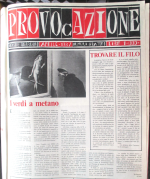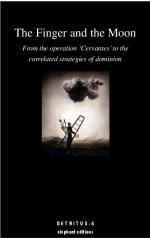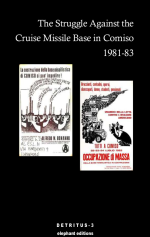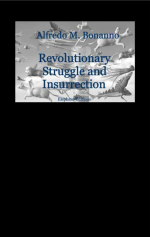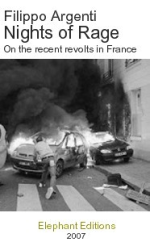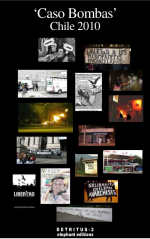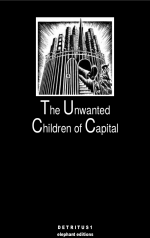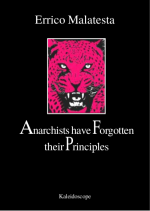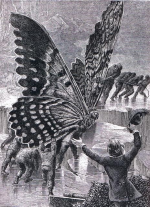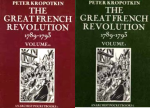Latest entries
ProvocAzione – Editorials Anarchist Monthly January 1987 – May 1991
This paper was born from the need to accompany the review “Anarchismo” with an agile publication capable of developing ‘circumscribed and condensed’ analyses. Political and social analyses, leaflets, communiques and documents of the anarchist movement as well as of other groups and organisations, as well as many short and very short articles concerning attacks on the structures of power, news items testifying forms of spontaneous rebellion, that are manifesting themselves with different modalities and often turn out to be quite extraneous to the specific ambit of the anarchist or antagonist movement.
Starting from a series of analyses — concerning among other things, the modifications in the productive structures, the perfectioning of information technology, transformations in the world of work and school, the progressive cultural emptying — a perspective of struggle is outlined: not only the attack on the ‘great temples of death’, on the ‘visible complexes that attract everybody’s attention’ but also and principally small and often simple objectives, peripheral structures spread over the whole territory that are beginning to take on increasing importance for capital: factories, commercial structures, seats of power, but also electricity pylons, communications cables, everything that combines in the development of capital and the continuation of exploitation. These analyses and proposals precede the publication of ‘ProvocAzione’ in part, but in this paper they are gone into further and turn out to be still, valid at the present time.
Starting from a series of analyses — concerning among other things, the modifications in the productive structures, the perfectioning of information technology, transformations in the world of work and school, the progressive cultural emptying — a perspective of struggle is outlined: not only the attack on the ‘great temples of death’, on the ‘visible complexes that attract everybody’s attention’ but also and principally small and often simple objectives, peripheral structures spread over the whole territory that are beginning to take on increasing importance for capital: factories, commercial structures, seats of power, but also electricity pylons, communications cables, everything that combines in the development of capital and the continuation of exploitation. These analyses and proposals precede the publication of ‘ProvocAzione’ in part, but in this paper they are gone into further and turn out to be still, valid at the present time.
Jun 10, 2017 Read the whole text...
The Finger and the Moon From the ‘Operation Cervantes’ to the correlated strategies of dominion
Distributed by Cassa Anarchica di Solidarietà Anticarceraria, Latina, 2005.
May 24, 2017 Read the whole text...
The struggle against the Cruise missile base in Comiso 1981–83
Comiso in Sicily became a prime place on the NATO nuclear armaments map, having been chosen to house 112 cruise missiles. A prosperous commercial and agricultural centre, it is characterised by poverty and unemployment, a situation that prevails among Sicilian peasants and manual workers. In contrast to what was being said by the Italian government — that the missile base would bring wellbeing and jobs to the area — some local anarchists (comrades in Ragusa and Catania) decided to give a more realistic picture based on the social and economic effects that such a base would have, along with the organisational proposal to form self-managed leagues in all the area, which would coordinate to occupy and destroy the base.
Mar 28, 2017 Read the whole text...
Alfredo M. Bonanno
Revolutionary Struggle and Insurrection
Our task as anarchists, our main preoccupation and greatest desire, is to see the social revolution come about: a terrible upheaval of men and institutions which finally succeeds in putting an end to exploitation and establishing the reign of justice.
Mar 21, 2017 Read the whole text...
Filippo Argenti
Nights of Rage
On the recent revolts in France
This booklet is a modest contribution to understanding the recent revolts in France. Needless to say, it is not sociological or, in a nobler sense, theoretical insight. Revolts can only be understood by those who have the same needs as the rebels, that is to say by those who feel they are part of the revolt. After a brief chronology, in fact, the pages that follow pose the question of how the events of November in France concern all of us, and also try to give a possible answer.
Mar 19, 2017 Read the whole text...
‘Caso Bombas’ Chile 2010
CHILE RECENTLY DOMINATED WORLD HEADLINES through the much publicised rescue of 33 miners entombed in the Atacama desert after the dilapidated, unstable mine they were working in collapsed. When the ‘accident’ took place on 5 August, there seemed little hope of saving their lives.
9 DAYS LATER, on August 14, public prosecutor Ricardo Peña gave the order to set in motion “Operation Salamandra”, in which agents of the BIPE (Investigation Police) the ERTA , the GOPE (Special Forces of the Normal Police), LABOCAR (CSI) and a series of helicopters and police cars were used to carry out 17 spectacular dawn raids in Santiago and Valparaiso.
9 DAYS LATER, on August 14, public prosecutor Ricardo Peña gave the order to set in motion “Operation Salamandra”, in which agents of the BIPE (Investigation Police) the ERTA , the GOPE (Special Forces of the Normal Police), LABOCAR (CSI) and a series of helicopters and police cars were used to carry out 17 spectacular dawn raids in Santiago and Valparaiso.
Mar 18, 2017 Read the whole text...
The Unwanted Children of Capital
What is a CPT (the Italian for immigration detention centre)? It is a place where the Italian State locks up all immigrants (children, women and men) who do not have stay permits. It is a modern concentration camp where undesirables are confined before being deported.
Immigration detention centres exist all over fortress Europe, as the bosses establish that only certain immigrants are allowed to stay; the others, those whose face doesn’t fit and cannot be exploited as cheap labour, are locked up in prisons especially created for them and held until they are deported. They are ‘guilty’ of coming from lands where mere surviving is impossible, owing to famine and war, desertification and ecological disasters, industrial reorganisation and mass dismissal.
Immigration detention centres exist all over fortress Europe, as the bosses establish that only certain immigrants are allowed to stay; the others, those whose face doesn’t fit and cannot be exploited as cheap labour, are locked up in prisons especially created for them and held until they are deported. They are ‘guilty’ of coming from lands where mere surviving is impossible, owing to famine and war, desertification and ecological disasters, industrial reorganisation and mass dismissal.
Mar 18, 2017 Read the whole text...
Errico Malatesta
Anarchists have forgotten their principles
At the risk of passing as a simpleton, I confess that I would never have believed it possible that Socialists—even Social Democrats—would applaud and voluntarily take part, either on the side of the Germans or on the Allies, in a war like the one that is at present devastating Europe. But what is there to say when the same is done by Anarchists—not numerous, it is true, but having amongst them comrades whom we love and respect most?
Mar 11, 2017 Read the whole text...
Alfredo M. Bonanno
Towards insurrection
To launch a struggle against a precise aspect of power that is oppressing us, against a repressive structure under construction like the maxi-prison, is to pose the question of destruction. Because that’s the only way to put a final end to the structure in question. To believe that an enormous project such as the maxi-prison can be prevented by the gentle voice of petitions and legalist opposition is not only to deceive oneself but also everyone else, all the oppressed and excluded. No, such a struggle must pose the question of insurrection: stopping the progression of power by force and self-organisation. But how pose this question? With the aid of attempts if not similar, at least moved by a similar will in the past, comrade Alfredo M. Bonanno will throw some light on this crucial question.
Mar 11, 2017 Read the whole text...
Peter Kropotkin
The Great French Revolution 1789–1793
Kropotkin’s work on the French Revolution is without doubt one of the fundamental interpretations of events that were to transform the destiny of humanity. Its importance lies in two premises: the design of a revolutionary development that is different and more significant than that usually suggested by bourgeois historians, and the individuation of the first symptoms of the current of thought and action which, a century later, was to take the name of anarchism.
Mar 4, 2017 Read the whole text...
Series
Fragments
Work in Progress
Anarchist Pocketbooks
Kaleidoscope
Anarchist Pamphlets
Bratach Dubh
Detritus
Drafts
Déjà vu
Insurrection (PDF)
Contact
e-mail: elephanteditions [at] riseup.net
Distributions
In Europe, Elephant Editions are distributed by Active Distribution
In the United States, Elephant editions are distributed by AK Press
In Italy, Elephant Editions are distributed by Edizioni Anarchismo
Other distributions please get in touch.

